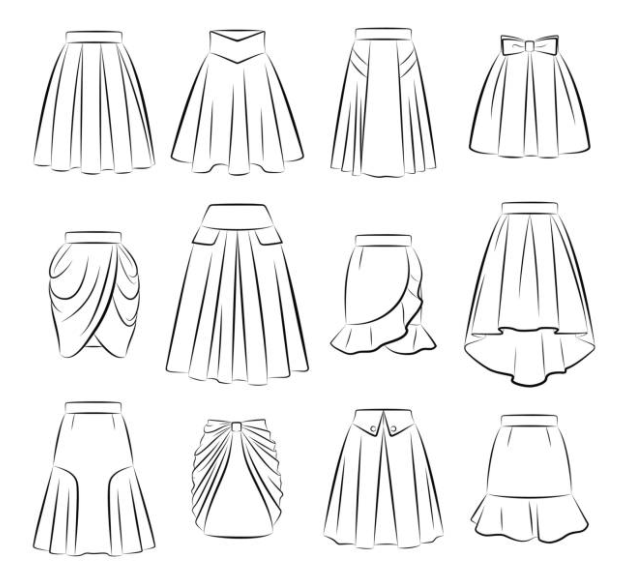Tugging their skirts down another inch, a group of girls walk through the halls refusing to meet certain teachers’ eyes. Others simply take a roundabout route to evade them entirely. Plagued with anxiety, discomfort, and frustration, these students go out of their way to avoid being reported for skirt infractions — colloquially known as being “skirted.” Since teachers are responsible for spotting dress code infractions, the accumulation of the year’s skirtings has placed a considerable strain on the student-teacher dynamic, which then negatively affects the entire school environment.
Understanding today’s skirt-related tension requires examining a policy change made two years ago. In response to students’ “desire for choice and voice,” High School Counselor Dr. Pam Mason said that AJA shifted from a strict uniform to a broader dress code. School logos, polo shirts, and khaki or navy bottoms made way for less restrictive options that provide room for student expression. Judaic Studies Instructional Team Leader Rabbi Allan Houben explained that administrators felt that shifting to a dress code from a uniform carried little downside and allowed students greater freedom.
The new dress code requires that skirts — now of any color of pattern — must, “at a minimum, [fall] to the middle of the knee while standing.” It adds that the “spirit of the dress codes” precludes “tight-fitting” skirts or those “with a slit above the knee.”
While tzniut (modesty) was a factor as administrators developed the dress code, simple enforcement was also heavily considered while making decisions. They aimed to minimize the number of different rules, hoping to make the new dress code “both simple to follow and simple to enforce,” according to Rabbi Houben. (Rabbi Houben helped develop the dress code guidelines, but he is not involved with enforcing dress code for female students.) After a first year that involved “a lot of fights that we [didn’t] actually care about having,” the administration lifted many restrictions on sweatshirt designs and eliminated the collar requirement for girls’ tops.
Rabbi Houben acknowledged that they also made changes in language, which he said aimed to avoid having the dress code “written one way and enforced another way,” such as moving to a requirement for skirts to only reach the middle of the knee, as opposed to covering the entire knee.
On multiple occasions in an interview for this article, Rabbi Houben stressed that the dress code also aims for ease of accountability, rather than only stemming from tzniut as many might assume. To illustrate his point, he explained that if AJA required midi skirts (which fall to the middle of the shin), the cut of the skirt would eliminate the conflict caused by a subjective mid-knee skirt-length requirement. However, observers would assume the policy found a basis in tzniut instead of what would have been the “real” reason: eliminating arguments and subjectivity. “In the absence of facts,” he said, “someone will always create a narrative.”
Regardless of intended objectivity, Dr. Mason noted that even in the planning stages, the administration knew that moving from a uniform to a dress code would inevitably necessitate greater enforcement since a dress code is less standard and straightforward than a uniform. The new absence of a girls’ collar requirement decreased the overall number of infractions from last school year to the current school year, yet she said that reported skirt infractions seemed to remain relatively constant from past years. In response to an inquiry from Palette, High School Team Leader Ms. Franeen Sarif said that AJA does not keep track of the number of the dress code infractions to compare from year to year.
According to protocol, if a teacher notices a student violating the dress code, they report the infraction on a faculty “Student Accountability” WhatsApp group. Learning Specialist and English teacher Ms. Amber Gardner added that sometimes teachers will double-check with another member of the faculty to ensure that the “[violation] is actually against the dress code.”
Once a teacher reports the infraction on the WhatsApp group, an administrator sends the student a generic, pre-written email that instructs them to change their clothes — generally a skirt. Trusting that “every teacher knows what the expectations are,” Dr. Mason confirmed that administrators do not verify infractions before sending out an email. She said the two main skirt dress code violations are skirts that are either too short or feature a slit that is too high.
In the dress code email that students receive, they are directed to a closet on the upper floor located adjacent to Ms. Sarif’s office to find replacement clothes into which they should change. To keep track of the skirts, students scan a barcode when they take out the skirts and scan it again when they return it. Dr. Mason explained that the system is designed such that a student could avoid any interpersonal interaction that might cause embarrassment.
To further avoid discomfort, Dr. Mason recalled that she enlisted a group of 11th and 12th grade girls to choose skirts on Amazon that skirted students would not feel ashamed to wear. “We don’t want anyone to feel like ‘I would never wear this,’” she said. “We wanted more variety, more types of skirts and sizes.”
In general, the administration expects students to periodically check their emails throughout the day, Dr. Mason said, and to change promptly if informed they are in violation of the dress code. When students have either not seen or ignored emails, “sometimes [they have] been reminded by a teacher to just check their email,” she said. Dr. Mason added that if the student still does not change, they can be assigned detention, although she hastened to clarify that the detention stems from the refusal to follow instructions, not the dress code infraction itself.
If a student disagrees with the email and believes their skirt complies with the dress code, they often discuss it with Ms. Sarif — mainly as a function of the fact that her office is closest to the closet, Dr. Mason claimed. Ms. Sarif also often brings Dr. Mason into the meetings.
Dr. Mason argued that “correcting” the infraction by wearing the garment differently, such as by pulling the skirt down, “is not a solution” because the student “should have been” wearing it like that the entire time. The school guidance counselor did not elaborate how often students prevail in this informal appeal process.
Students are not informed which aspect of the dress code their skirt violates, nor are they informed which teacher reported them. In the beginning of the year, rather than the anonymous email sent now, students initially received the email from Athletic Director Coach Rodney Zimmerman.
Many students expressed to the administration that receiving this notification from Coach Z felt uncomfortable. Ms. Sarif acknowledged that sending an email about girls’ dress code from a male faculty member caused “a rough start and it wasn’t right… It wasn’t a shining moment in the way we were handling it.” Although the dress code emails technically came from Coach Z, since he was initially “put, overall, in charge of all the discipline,” female faculty actually drafted the letter, according to Ms. Sarif.
The administration addressed the discomfort expressed from Coach Z’s email signature and, “as a result of that, we made changes,” Ms. Sarif said, meaning that Coach Z’s signature would no longer be on emails. Dr. Mason assured students that the system is separated by gender, so female teachers only report female students’ dress code infraction.
Although the email now comes from an account specifically for student accountability, this does not always ensure complete anonymity: “There was this one time when I saw a teacher looking at my legs, and then two minutes later, I got an email, so I knew who the teacher was [who reported me],” recalled senior Noa Mishli. She could not help but then feel that the teacher deliberately “picked on [her]” and “did not like [her].”
In addition, sometimes teachers will approach students directly instead of reporting on the WhatsApp chat. After sophomore Ayla Cohen had this very experience, she said, “This led me to not trust the teacher as much and definitely lowered my opinion of them.”
However, from the teachers’ end of the encounter, they do not feel it causes any disruption to their relationship with students. History teacher Dr. Corrie Stephensons said, “I don’t really feel like it inhibits my relationship with students at all.” Mrs. Brand also explained that as a school authority figure, she believes that students expect her to keep them accountable in all aspects of high school. When she does tell a student that their outfit does not meet the guidelines, she says that sometimes “they get mad in my face about it, but that anger that they’re directing at me is not really at me — they just either don’t like the policy or don’t like that they got caught.”
Regardless of its specific guidelines, overall, the high school teachers agree that instituting a dress code better prepares students for success in the future. In almost every career, students will be expected (or required) to dress a certain way. Science teacher Mrs. Catherine Brand explained, “Part of our job is to train [students] for a professional future. We cannot do that if we don’t also teach [them] about how to professionally comport [themselves] in terms of appearance.” History teacher Mrs. Hana Hecht similarly believes, “High school is also where they are given guidance on how to make better choices, and the dress code is just one of many ways we teach students how to be successful.”
Furthermore, many teachers also believe that enforcing a dress code helps create focus inside the classroom. “The point of a dress code is that we all put ourselves in a mind for education,” said Mrs. Brand. Regardless of students’ conscious awareness or intention, “how students dress in the classroom affects the learning environment. Dressing appropriately shows respect for the class as well as the teacher,” said Mrs. Hecht. Whether or not a school centers around a certain religion or value, teachers believe that mandating certain dress guidelines serves as a basic protection of the learning environment.
However, AJA students have found that a dress code can also damage the learning environment. Senior Gefen Beldie explained, “When you walk into a room, have a teacher look down at your knees, and start typing on their computer, you have this feeling of anxiety because you’re just waiting to be dressed coded… It’s really uncomfortable and it leads to a bad environment in the school.”
Being skirted can strongly disrupt a student’s school experience. Senior Noa Mishli recalled one week when she received a dress code infraction email every single day. By the end of the week, she just wanted to stay home because of how uncomfortable it felt knowing that teachers were constantly scrutinizing her skirts.
While many students understand and accept the principles of the dress code, they feel that its enforcement creates an uncomfortable atmosphere. Since the dress code is partly related to religious values, being skirted feels emotionally charged. Gefen elaborated, “It kind of gives you this feeling of feeling dirty or wrong… It is a dress code that we believe follows our Modern Orthodox values, so in that sense, it doesn’t just feel like you’re breaking a school rule, but you’re disrespecting your community.”
Junior Racheli Seeman believes this feeling comes from how the school talks about dress. Occasionally during the year, a female, Jewish high school teacher will decide to sit down with all the girls and ask them to better follow the dress code, since the way that a girl dresses conveys her values and affects how others view her. Racheli explained, “Dress code talks are rarely about ‘this is the rule, you didn’t follow it; therefore, there are consequences.’ It’s often telling girls — almost always only girls — that we don’t respect ourselves because we don’t follow the dress code and that we are disconnected from our faith.”
From the students’ perspective, the current system leads to a tense relationship between them and their teachers. Since administration tasks teachers with spotting dress code infractions, it adds a different layer to the student-teacher dynamic. “We, as students, know when a teacher walks by and intentionally looks down at our knees to see if our skirts meet the appropriate dress code length. It’s very uncomfortable knowing and seeing a teacher do that,” said freshman Mollie Glazer.
Much of the students’ discomfort arises from what they claim to be inconsistent enforcement from teachers. Junior Dalya Silverman remarked, “Without consistency, students are going to feel more targeted.” Gefen encountered “situations where [she’ll] be the only girl dress coded out of a group of girls wearing practically the same thing.” When this occurs, being skirted feels personal.
Beyond what appears to be illogically and disproportionately skirting certain girls, some students also experience inconsistent reporting of their own skirts. Sometimes, if an administrator does not have a chance to send an email right after the infraction is reported, students will receive infraction emails in their last classes of the day (or even after school ends). However, from the student’s perspective, it seems that in the afternoon the skirt randomly no longer meets requirements. This causes students’ minds to run wild trying to make sense of what happened: Did their last period teacher think the skirt was too short? Yet, no other teachers thought that — so was this teacher simply out to get them? What had they done to anger the teacher?
Dalya remembers wearing a certain skirt one day, and opening her email to see a notification that she violated dress code. However, Dalya wore that skirt twice more, and never again received any infraction emails. The skirt remained the same, yet the administration’s response changed completely, perpetuating confusion surrounding the true skirt expectations.
The teachers and administration admit inconsistency in enforcement. Rabbi Houben said, “I think that the challenge with dress code is it’s never going to be 100% consistent.” Dr. Mason also noted, “I don’t think consistently every day we’re reporting every infraction. And I think if we did that, it would be clear for students to understand what the expectations were.”
Part of this inconsistency stems from the policy change in skirt length requirement. Last year, many teachers were ecstatic to hear that skirts must cover the entire knee; this created a fool-proof enforcement mechanism: if they could see a student’s knee, the student was not in dress code. Now, when the skirt simply needs to fall to the middle of the knee, a ruling becomes much murkier.
This change in the dress code is also unclear to many teachers. While the dress code clearly states that skirts must fall, at a minimum, to the knee, in passing during an interview with Palette, one teacher mentioned that a skirt needs to simply reach the “top of the knee.” However, when another teacher spoke with Palette, she stated, “It says that your skirt should cover your knees when sitting and standing — that’s pretty clear. If you’re standing and we can see your knees, you’re not honoring the dress code.” When teachers have different rules in mind when looking for infractions, consistency is impossible.
Moreover, due to human nature, teachers simply cannot enforce dress code perfectly. While Dr. Stephenson said she strives to be fair, she also said, “I’m human, and I’m fallible. I may not catch [a student] one time when [they’re] wearing something inappropriate.” To expect absolute consistency places an unattainable benchmark for teachers.
Both Rabbi Houben and Dr. Mason feel that tension will only be alleviated if the administration and students collaborate. “Our school is unique in the sense that students have a voice here… Our goal isn’t to be top down and just dictate the rules,” said Rabbi Houben. “We’re very happy to engage in conversation, and many things about school have been adjusted or shifted based on those conversations when they are met with openness, honesty, and real reflection from students.”
He added that if students help create a plan for dress code enforcement, he believes the dress code policy itself would not feel as charged. He believes that if a student finds themselves in a situation where they are notified of an infraction, they would “feel better about it because [they] were part of creating the system that was employed.” However, until students and administration can come together to make a change, the tension and rift among students and teachers will remain.
This story was originally published on May 24, 2021.












